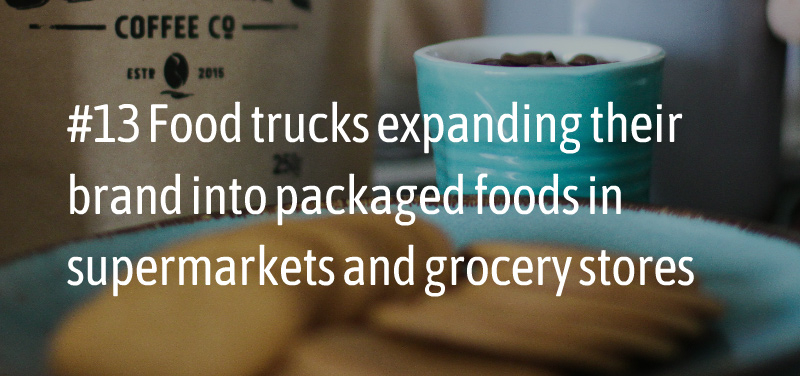Food Truck Market Trends
Food trucks are a very popular vehicle for serving delicious and quick foods to crowds without the high overhead of owning a brick and mortar restaurant.
QSR states that there are more than 4000 food trucks in the USA with annual sales over $1.2 billion. It furthermore states from IBISWorld that food truck revenue has spiked at a yearly rate of 7.9 percent in just five years.
With spring nearly upon us, food trucks are a wonderful option for local workers and residents to enjoy a quick bite for lunch or a snack with friends and colleagues. Read on to gather some trends and ideas for maintaining your food truck operation business this season.
Current Market Trends

In 2008, when the US recession was shuttering down businesses, restaurants, and retail, the food truck industry started to grow. Mobile Cuisine observes that during the recession, food trucks began appearing, offering more affordable options for consumers with less overhead for food truck operators. Furthermore, with steady growth, Mobile Cuisine still anticipates the industry will face certain challenges, particularly regulatory issues such as parking laws, which are still adapting and evolving in many cities. Food truck associates may need to work alongside city governments to fuse these disconnects to continue the booming success of food truck hubs in major cities.
IBIS quotes that for future success, food truck operators must maintain and control inventory, have close proximity to cities or key markets and have a license to operate.

QSR also anticipates seeing a growing market in private food truck rentals such as at special events like weddings, Bar Mitzvahs, and used as marketing incentives to draw the public in at store openings, and public gatherings such music festivals and other outdoor happenings.
Trends in Food & Beverage


A few years ago, when food trucks began to find popularity, one may have found a basic assortment of cozy, homemade comforts like mac and cheese, or a good old-fashioned greasy burger. But now with more health-conscious consumers and a larger market for unique and flavorful beverages, trends are changing. Below are some trends Mobile Cuisine anticipates seeing in food in 2018:
- New cuts of meat
- House-made condiments
- Ethnic-inspired breakfast items
- Sustainable seafood
- Healthful kids’ meals
- Vegetable carb substitutes
- Authentic ethnic cuisine
- Ethnic condiments/spices
- Peruvian cuisine
- Housemade/artisan pickles

Additionally, with the rise of beverages playing a big role in food trucks, Mobile Cuisine foresees the following trends in non-alcoholic drinks:
- House-made/artisan soft drinks
- Cold-brew coffee
- Gourmet lemonade
- Locally/house roasted coffee
- Specialty iced tea
- Specialty teas
- Mocktails
- Kombucha
- Coconut water
- Flavored/enhanced water
Customer-Driven Apps & Technology Trends

Most food-related industries rely heavily on apps, social media, and technology. QSR insists that technology, especially social media, are quite important in the food truck model. Operators once just relied on social media standbys such as Facebook and Twitter, but the market has grown over the last several years. Social media outlets like Snapchat and Instagram are becoming important platforms for food truck associates since these social media tools are now major players for their consumers. Food truck operators can use these platforms to share their truck locations, menu specials, and other important news. Building a following on one or several of these channels can increase exposure and eventually business.

Furthermore, Food Truck Operator states that “39 percent of millennials use tech to order food, and according to Technomic, a consulting firm for the food industry, food delivery could become a $3 to $5 billion market in the next decade.” Food truck owners saw an opportunity in the rising online ordering trend. Increasing number of food trucks are letting customers place their orders online while at a different location or even while waiting in line at the food truck through a dedicated smartphone app. This proved to prevent losing a customer to a long line.

Although many food truck operators find online review sites such as Yelp and Google to be pesky, embracing the trend and engaging with customers on these platforms may yield more business, especially with younger consumers.

With so many people addicted to their smartphones, a food truck operator may want to consider bringing WiFi to their food truck. Mobile Cuisine outlines a few simple steps called tethering, which could help food truck operator’s smartphones become a hotspot, keeping nearby customers happy and connected as they enjoy their outdoor lunch.
Drawing in Younger Customers – Focus on Millennials Trends

It’s no secret that the millennial generation is changing how many businesses are operating. These individuals are powerful consumers and trendmakers.
Food Truck Operator has these tips for growing potential millennial followers:
- Creativity and customization – make the customer feel in control as “chef” and let them choose the toppings and components of their order. Millenials are drawn to trying new foods and authenticity, so try to keep the menu fresh, and creative with various options.
- Think about the source and food/animal welfare – Millenials are very drawn to foods that are organic, non-GMO, and respect when animals are treated well like grass-fed beef or pasture-raised chickens and tend to be interested in where foods are sourced such as a local farm.

Food Truck Operator continues that, “with over $200 billion in foodservice buying power, you’ll want these consumers to keep coming to your truck. With the right mindset and company mission, these millennials could just become your loyal customers and workforce for years to come.”
Beyond the Truck Trends

British Street Food has some insight into the UK food truck vehicle operations. In addition to a traditional truck with the driver, food truck operators are beginning to become creative with their actual “vehicle,” such as utilizing shipping containers, which are durable, well-priced, and easy to set up. Anticipate seeing clusters of shipping containers as food trucks used within in-the-meantime space and near retails areas.

QSR is also seeing a trend of food trucks expanding their brand into packaged foods in supermarkets and grocery stores. Customers can now find some of their favorite foods and beverages just steps from their home. Additionally, British Street Food has observed some brands becoming so successful that they are choosing to grow beyond the truck, and open a brick and mortar storefront, being able to serve their customers in a more consistent format.

Food Truck Operations & Management Trends
With so many trends and ideas to ponder, it can be a bit overwhelming to manage food truck operations. But food truck operational aspects are not to be overlooked as mastering it becomes a huge competitive advantage on this increasingly crowded market.

IBIS World, a market research company, indicates technology which enables the use of smartphones and tablets to take payments, as one of the biggest opportunities for the food truck market. Food trucks choosing the right POS technology that responds to this market need, are setting themselves at the forefront of customer expectations.

Another key trend, indicated by IBIS World as an opportunity for food truck market, is the ability to control stock on hand. Being able to control stock in real time is the answer to one of the biggest operational issue of food trucks – running out of stock in rush hours.




